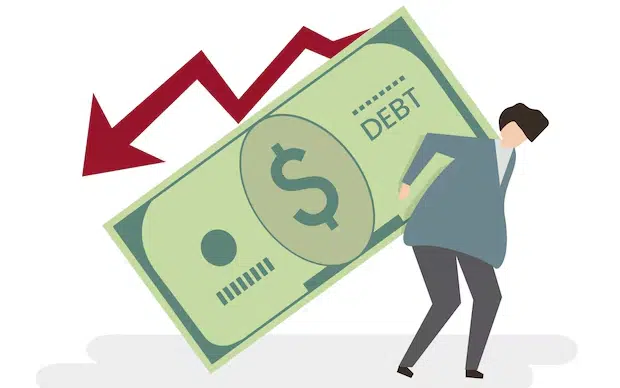Managing personal and national debt amid a high-inflation scenario poses significant challenges for the United States. Rising inflation impacts not only the value of money but also the cost of living, borrowing, and investments. As inflation rates climb, individuals and businesses find themselves navigating a complex financial environment with increased uncertainty.
This challenge becomes even more pronounced when trying to manage existing borrowings, as the cost of repayments can escalate alongside inflation. In this blog post, we will explore the intricacies of handling liabilities during periods of rapid inflation, and offer some strategies to mitigate the associated financial strain.
Understanding the impact of inflation on debt

Inflation affects debt in multiple ways, often complicating the task of repayment. As inflation rises, the purchasing power of money decreases. This means that consumers and businesses need more money to buy the same goods and services. Consequently, individuals who have fixed-rate debts may find themselves with an advantage, as the real value of their remittances diminishes over time.
Moreover, inflation can impact overall economic confidence, curbing consumer spending and business investment. This creates a challenging scenario for debt management as income growth may not keep pace with inflation. The disparity between income and expense growth could lead to higher indebtedness over time.
The role of interest rates
Interest rates play a pivotal role in the high-inflation scenario, influencing both the cost of debt and the broader economic landscape. Central banks often raise rates in response to inflationary pressures to curb spending and stabilize the economy. This action, while beneficial in controlling inflation, can significantly increase the cost of borrowing for individuals and companies alike.
For consumers, increased interest rates can affect everything from mortgage and auto loan payments to the cost of using credit cards. This amplified burden can lead to reduced disposable income, affecting their ability to spend on other necessities and impacting economic growth. Thus, it becomes imperative for individuals to consider refinancing options or consolidating obligations to manage increased costs effectively.
Businesses also face challenges as higher rates can dampen investment and expansion plans. Companies may find taking on new debt costly, thereby affecting their operations and growth initiatives. They must seek alternative funding sources or optimize their existing debt structures to remain competitive in a high-rate environment.
Comparing fixed-rate and variable-rate debt
Choosing between fixed-rate and variable-rate debt instruments can significantly affect debt management strategies in an inflationary economy. Fixed-rate debt offers consistent payments, making financial planning more predictable even when inflation rates are rising. This stability can be advantageous for budget-conscious borrowers who prefer certainty in their financial commitments.
On the other hand, variable-rate debt can initially be more appealing due to typically lower starting interest rates. Yet, these loans carry the risk of rate hikes, which can exponentially increase repayment amounts in response to inflationary pressure. These fluctuations may strain borrower finances if not anticipated and managed adequately.
Strategies for effective debt management
Effective debt management during high-inflation periods demands careful planning and strategic decision-making. Borrowers should focus on reducing high-interest liabilities as a priority, preventing further accumulation of costly debts. Refinancing existing loans at lower, fixed rates can also prove beneficial, providing a shield against rising interest costs.
Another strategy involves reviewing and adjusting personal budgets to accommodate higher costs due to inflation. Identifying and cutting non-essential expenditures can free up resources to manage debt more aggressively. Additionally, increasing income streams through side jobs or investments can provide extra funds to alleviate pressure.
Staying informed about economic trends and potential policy changes is also vital. Knowledge empowers consumers to anticipate market shifts and adjust their strategies proactively. Education about different financial tools and resources can further aid in navigating the uncertainties of managing debts in inflationary times.
Leveraging professional financial advice
Engaging a professional financial advisor can be an instrumental step in managing debts during inflationary periods. An experienced advisor provides tailored guidance based on individual financial circumstances and long-term goals. Advisors can assist in creating a robust debt management plan that prioritizes financial health, incorporating elements such as refinancing options and interest rate forecasts.
They can also offer insights into market trends and potential investment opportunities that align with their clients’ risk tolerance and timeline. By leveraging their expertise, consumers can make informed decisions that align with their financial objectives, minimizing potential pitfalls.
Utilizing technology for debt management
Technology offers numerous tools designed to aid effective debt management, especially important during periods of high inflation. Financial apps and software provide platforms for tracking expenses, setting budget goals, and monitoring progress. They allow users to visualize their financial position in real-time, promoting responsible spending and timely repayments.
Online calculators and simulators help in understanding the effects of interest rate changes on future payments, empowering users to make informed decisions about refinancing or restructuring existing loans. Automated reminders and alerts ensure timely payments, reducing the risk of accruing additional charges.
